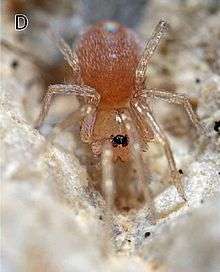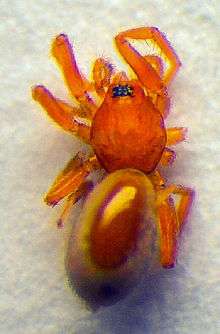Oonopidae
| Oonopidae | |
|---|---|
 | |
| Female Tapinesthis inermis | |
| Scientific classification | |
| Kingdom: | Animalia |
| Phylum: | Arthropoda |
| Subphylum: | Chelicerata |
| Class: | Arachnida |
| Order: | Araneae |
| Infraorder: | Araneomorphae |
| Family: | Oonopidae Simon, 1890[1] |
| Genera | |
|
See text. | |
| Diversity[2] | |
| 113 genera, 1,613 species | |
 | |
Oonopidae is a family of spiders commonly known as goblin spiders, consisting of over 1,600 described species in about 113 genera worldwide,[2] with total species diversity estimated at 2000 to 2500 species.[3] The type genus of the family is Oonops Keyserling, 1835.
Goblin spiders are generally tiny, measuring about 1 to 3 millimeters. Some have scuta, hardened plates on their abdomens. Oonopids usually have six eyes, the anterior median eyes having been lost. However, four-eyed (Opopaea viamao), two-eyed (e.g. Coxapopha, Diblemma) and even completely eyeless species (e.g. Cousinea, the cave-dwelling Blanioonops) are also known. The family is permeated with unusual morphological traits, many of which are limited to males. Examples include heavily modified mouthparts (e.g. Coxapopha, Xyccarph), sternal pouches (sometimes alternatively called holsters; e.g. Grymeus) and extensions of the carapace (e.g. Ferchestina, Unicorn). The male pedipalps are also often highly modified. The genus Opopaea, for example, exhibits an expanded palpal patella while male Ischnothyreus are characterized by completely sclerotized, pitch-black pedipalps. Members of the genus Orchestina are believed to be able to jump, as both sexes have greatly enlarged femora on the fourth leg pair.
Oonopidae are seldom seen by people as they are too small to be easily noticed. They are generally found in the leaf litter layer and under rocks, but they also constitute a significant component of the spider fauna living in the canopy of tropical rainforests. Three blind Afrotropical genera (Anophthalmoonops, Caecoonops, Termitoonops) are exclusively found in termite nests. A few species, such as the pantropical Heteroonops spinimanus and Triaeris stenaspis, are thought to be parthenogenetic as no males have yet been collected.
Fossil record
Oonopidae are frequently encountered as subfossils preserved in copals and as fossils preserved in amber. Oonopids even occur in more amber deposits than any other spider family, which may be accounted for by their widespread distribution, small size, and wandering behaviour, as amber appears to be biased towards trapping such spiders. In contrast, sedimentary fossils of Oonopidae are unknown.
Most fossil oonopids described from amber are assigned to the extant genus Orchestina. This genus was already widespread by the end of the Cretaceous, as indicated by specimens found in amber dating back approximately 100 million years. This makes Orchestina the oldest extant spider genus along with the Archaeidae. Orchestina's fossil record even includes a pair of spiders that were entombed during copulation.
Systematics
As of November 2015, the World Spider Catalog accepted the following genera:[1]
- Anophthalmoonops Benoit, 1976
- Antoonops Fannes & Jocqué, 2008
- Aposphragisma Thoma, 2014
- Aprusia Simon, 1893
- Aschnaoonops Makhan & Ezzatpanah, 2011
- Australoonops Hewitt, 1915
- Bannana Tong & Li, 2015
- Bidysderina Platnick et al., 2013
- Bipoonops Bolzern, 2014
- Birabenella Grismado, 2010
- Blanioonops Simon & Fage, 1922
- Brignolia Dumitrescu & Georgescu, 1983
- Caecoonops Benoit, 1964
- Camptoscaphiella Caporiacco, 1934
- Cavisternum Baehr, Harvey & Smith, 2010
- Cortestina Knoflach, 2009
- Costarina Platnick & Dupérré, 2011
- Cousinea Saaristo, 2001
- Coxapopha Platnick, 2000
- Dalmasula Platnick, Szüts & Ubick, 2012
- Diblemma O. Pickard-Cambridge, 1908
- Dysderina Simon, 1891
- Dysderoides Fage, 1946
- Emboonops Bolzern, Platnick & Berniker, 2015
- Escaphiella Platnick & Dupérré, 2009
- Farqua Saaristo, 2001
- Gamasomorpha Karsch, 1881
- Gradunguloonops Grismado et al., 2015
- Grymeus Harvey, 1987
- Guaraguaoonops Brescovit, Rheims & Bonaldo, 2012
- Guatemoonops Bolzern, Platnick & Berniker, 2015
- Heteroonops Dalmas, 1916
- Hexapopha Platnick, Berniker & Víquez, 2014
- Himalayana Grismado, 2014
- Hortoonops Platnick & Dupérré, 2012
- Hypnoonops Benoit, 1977
- Hytanis Simon, 1893
- Ischnothyreus Simon, 1893
- Kapitia Forster, 1956
- Khamiscar Platnick & Berniker, 2015
- Khamisia Saaristo & van Harten, 2006
- Khamisina Platnick & Berniker, 2015
- Khamisoides Platnick & Berniker, 2015
- Kijabe Berland, 1914
- Lionneta Benoit, 1979
- Longoonops Platnick & Dupérré, 2010
- Lucetia Dumitrescu & Georgescu, 1983
- Malagiella Ubick & Griswold, 2011
- Megabulbus Saaristo, 2007
- Megaoonops Saaristo, 2007
- Melchisedec Fannes, 2010
- Molotra Ubick & Griswold, 2011
- Neotrops Grismado & Ramírez, 2013
- Neoxyphinus Birabén, 1953
- Nephrochirus Simon, 1910
- Niarchos Platnick & Dupérré, 2010
- Noideattella Álvarez-Padilla, Ubick & Griswold, 2012
- Noonops Platnick & Berniker, 2013
- Oonopinus Simon, 1893
- Oonopoides Bryant, 1940
- Oonops Templeton, 1835
- Opopaea Simon, 1891
- Orchestina Simon, 1882
- Ovobulbus Saaristo, 2007
- Paradysderina Platnick & Dupérré, 2011
- Patri Saaristo, 2001
- Pelicinus Simon, 1891
- Pescennina Simon, 1903
- Plectoptilus Simon, 1905
- Ponsoonops Bolzern, 2014
- Predatoroonops Brescovit, Rheims & Ott, 2012
- Prethopalpus Baehr et al., 2012
- Prida Saaristo, 2001
- Prodysderina Platnick et al., 2013
- Pseudodysderina Platnick, Berniker & Bonaldo, 2013
- Pseudoscaphiella Simon, 1907
- Puan Izquierdo, 2012
- Reductoonops Platnick & Berniker, 2014
- Scaphidysderina Platnick & Dupérré, 2011
- Scaphiella Simon, 1891
- Scaphioides Bryant, 1942
- Scaphios Platnick & Dupérré, 2010
- Semibulbus Saaristo, 2007
- Semidysderina Platnick & Dupérré, 2011
- Setayeshoonops Makhan & Ezzatpanah, 2011
- Sicariomorpha Ott & Harvey, 2015
- Silhouettella Benoit, 1979
- Simlops Bonaldo, Ott & Ruiz, 2014
- Simonoonops Harvey, 2002
- Socotroonops Saaristo & van Harten, 2002
- Spinestis Saaristo & Marusik, 2009
- Stenoonops Simon, 1891
- Sulsula Simon, 1882
- Tapinesthis Simon, 1914
- Telchius Simon, 1893
- Termitoonops Benoit, 1964
- Tinadysderina Platnick, Berniker & Bonaldo, 2013
- Tolegnaro Álvarez-Padilla, Ubick & Griswold, 2012
- Toloonops Bolzern, Platnick & Berniker, 2015
- Triaeris Simon, 1891
- Tridysderina Platnick, Berniker & Bonaldo, 2013
- Trilacuna Tong & Li, 2007
- Unicorn Platnick & Brescovit, 1995[4]
- Varioonops Bolzern & Platnick, 2013
- Vientianea Tong & Li, 2013
- Volborattella Saucedo & Ubick, 2015[5]
- Wanops Chamberlin & Ivie, 1938
- Xestaspis Simon, 1884
- Xiombarg Brignoli, 1979
- Xyccarph Brignoli, 1978
- Xyphinus Simon, 1893
- Yumates Chamberlin, 1924
- Zyngoonops Benoit, 1977
Gallery
.jpg)
.jpg)

 Xestaspis shoushanensis
Xestaspis shoushanensis
See also
Notes
- 1 2 "Family: Oonopidae Simon, 1890 (genus list)", World Spider Catalog, Natural History Museum Bern, retrieved 2015-11-10
- 1 2 "Currently valid spider genera and species", World Spider Catalog, Natural History Museum Bern, retrieved 2015-11-10
- ↑ Busschere, C., Fannes, W., Henrard, A., Gaublomme, E., Jocqué, R., & Baert, L. (2014). "Unravelling the goblin spiders puzzle: rDNA phylogeny of the family Oonopidae (Araneae)" (PDF). Arthropod Systematics & Phylogeny. 72 (2): 177–192.
- ↑ Platnick, N.I. & Brescovit, A.D. (1995). On Unicorn, a new genus of the spider family Oonopidae (Araneae, Dysderoidea). American Museum Novitates 3152: 1-12.
- ↑ Saucedo, A. D., Ubick, D., and Griswold, C. E. (2015). The goblin spiders of the new genus Volborattella (Araneae: Oonopidae) from Madagascar. American Museum Novitates 3822 1-71.
References
- Jocqué, R. & Dippenaar-Schoeman, A. S. (2006). Spider Families of the World. Royal Museum for Central Africa. 336 pp. ISBN 90-75894-85-6.
- Penney, D. (2004). New spiders in upper Cretaceous amber from New Jersey in the American Museum of Natural History (Arthropoda: Araneae). Palaeontology 47(2): 367-375.
- Penney, D. (2006). Fossil oonopid spiders in Cretaceous ambers from Canada and Myanmar. Palaeontology 49(1): 229-235.
External links
| Wikispecies has information related to: Oonopidae |
| Wikimedia Commons has media related to Oonopidae. |
- Goblin Spider Planetary Biodiversity Inventory. American Museum of Natural History.